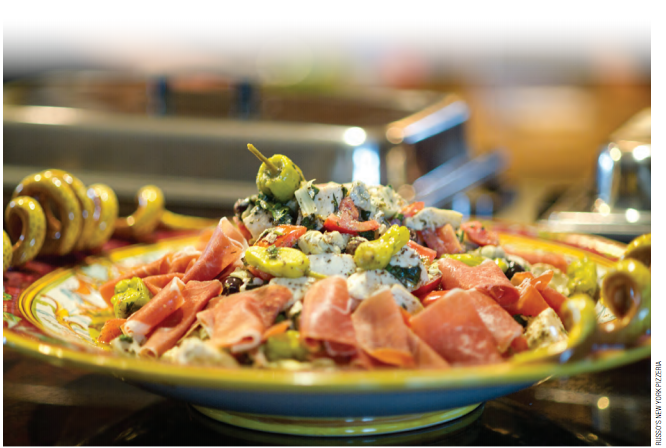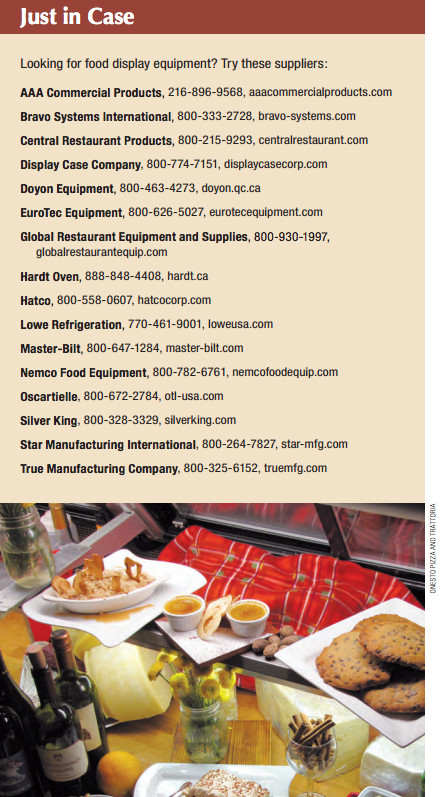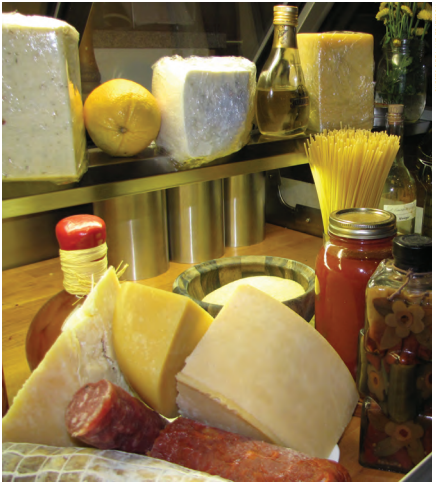
“Seeing is believing” might be a cliché, but the phrase still rings true when it comes to showcasing the food on your menu. By putting items such as desserts, specialty pizzas and pastas on display where customers can see them when they walk in the door (or even in your front window for passersby), you can whet appetites and upsell items to increase the average ticket at your pizzeria. “Customers eat with their eyes,” notes Anthony Russo, owner of Russo’s Coal Fired Italian Kitchen and Russo’s New York Pizzeria (russorestaurants.com), based in Houston. “They love to see the food we offer!” We spoke to operators to find out how they’ve made food displays work for them—and what advice they can share with other operators on how to make this tactic a success.
Great Ideas

If you’re wondering which of your food items to display, it’s best to consider your business model and your customers. Michele Coen Racanelli, owner of Onesto Pizza and Trattoria (onestopizza.com) in St. Louis, displays desserts, meats and cheeses for antipasti plates, seasonal pickled items, wines, and mason jars of the pizzeria’s own sauces that are for sale. “Our restaurant often has a one- to one-and-a-half-hour wait on weekends, so displaying our food shows customers the flavors and variety of what we offer,” she explains. “The hostess and the counterperson can also talk to people waiting, and answer any questions they might have about the food they see.” If your pizzeria frequently has a wait for dine-in, or if customers often wait for to-go orders inside your pizzeria, it’s wise to take advantage of this captive audience by putting some of your most unique or visually appealing foods on display and having your staff engage customers in a conversation about the menu. In some instances, this experience can guide an entire order—such as when a customer sees a particularly mouthwatering dessert up front and decides to save room for it while eating his main course.
At Villa Fresh Italian Kitchen (villapizza.com), which has hundreds of locations (many in competitive food court settings), a wide range of displayed menu items draws customers. “We display all of our freshly prepared food on hot tables or steam tables, or in cold wells, to keep products at the ideal temperature and to fully showcase them, so our guests see firsthand the variety of our items,” says Paula Doyle, vice president of marketing for Villa Enterprises, headquartered in Morristown, New Jersey. “Displaying our products helps contribute to appetite appeal and impulse purchases in our high-traffic locations; it’s a lot more appealing to see what you’re ordering rather than just reading a name off a menu board.” Accordingly, Villa displays pizzas (Neapolitan, Sicilian and stuffed styles), pastas, chicken entrees, sides and salads to tempt an assortment of tastes.
Russo, on the other hand, devotes his displays to those items that aren’t on the menu: Up to eight specials are showcased, including entrees, pastas and salads, during lunch hours only. Because the specials change weekly and offer a seasonal focus, customers are more apt to return to see what’s cooking on any given day. “Keeping our displays fresh and new definitely helps our sales,” says Russo. “Instead of a customer coming in every two to three months, he can return frequently to see our specials—we might display our eggplant rollatini one week, then seafood cannelloni the next.” To educate customers about these off-the-menu items, he places a card with the name of the dish right next to each display, which also helps with sales for customers who come in for to-go orders. “We display right next to the register so the customer can see everything, and the displays help the staff doing counter service,” he says. “Not only does the food look beautiful on the counter, but it helps educate our customers about the many items we offer.”
Coen Racanelli has found yet another perk of her food displays—they’ve revved up her catering business. “When we display our food items, we’ll have catering cards and menus right near them, because our displays give customers an idea of how we’d set up for a catering event,” she explains. “Thanks to this tactic, we go through 25 catering cards every week, and catering now makes up one-fifth of our annual sales.” The catering business, in return, helps Coen Racanelli with Onesto’s displays: If there’s some leftover tapenade or hummus from a batch prepared for a catering order, she’ll display it in front so waiting customers can try the food firsthand. Similarly, when customers see cheeses on display in the case, they’ll often ask for a sample to try, and once seated will order one of Onesto’s cheese flights. Therefore, pizzeria owners might consider incorporating sampling efforts along with their displays—once customers try a bite of that specialty pizza or pasta, they’ll be more likely to request it on this or their next visit!
Avoiding the Pitfalls
Displaying food can be a great way to get customers excited about your menu items, but they can also turn off customers if certain requirements aren’t met. Take these operator tips into consideration for any food displays you set up in your pizzeria:
Presentation is everything. Your dishes on display should be designed and presented to wow your customers. “Pick attractive, colorful dishes, like chicken in pesto sauce,” suggests Russo. “You don’t want to put out your spaghetti and meatballs or baked ziti—they’re not as colorful, and everyone already knows what they look like!” Russo also suggests using the freshest produce, and avoiding lackluster-looking items such as canned vegetables.
Educate staff. Coen Racanelli notes the importance of staff being familiar with every item on display so they can answer customers’ questions and engage in upselling (even better, make sure that staff members working near food displays have actually tried the food, so they can give heartier recommendations). However, even when staff is at its busiest, you can still educate about your items; Coen Racanelli suggests putting up name cards or small signs to let people know what each item is.

Consider maintenance needs. If your food on display isn’t consistently looking as fresh and delicious as it’ll appear when it emerges from thekitchen, what’s the point? Make sure that food’s appearance is maintained for as long as those items are displayed. “Ensuring the product continues to look good after it comes out of the oven, or as the product is depleted when purchased, are issues our employees and managers are constantly considering,” says Doyle. “Our managers also act as our in-store visual merchandisers, constantly checking to make sure our displayed product is at its visual best to tempt the palates of hungry guests!” Hence, you may want to assign a certain member of staff to ensure that food is kept fresh-looking at all times.
Choose the right display. Before you begin to display food in your pizzeria, you’ll need to invest in the best display case(s) to fit your needs. For example, if you’re displaying cheesecake and put it in a large case with other foods, the flavors might mix and make your dessert taste less than its best (for this reason, Coen Racanelli suggests putting only one or two slices on display instead of the entire cake). “Cases are not cheap, so think about what you’ll put in there and what’s feasible to display; ask yourself if you can keep up with it and keep everything looking fresh, before you make the investment,” she advises. “But when the display looks clean and the food is fresh, it’s a great place to showcase what you can do.”














